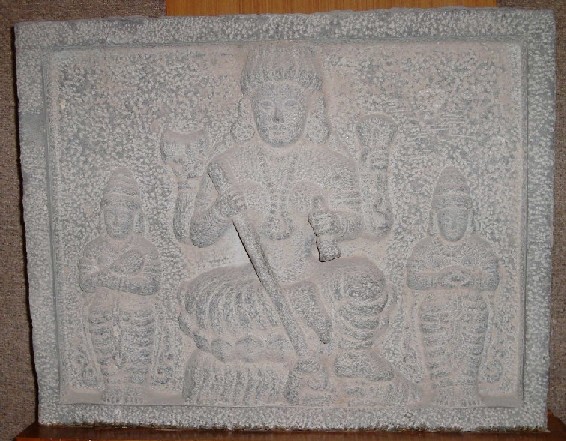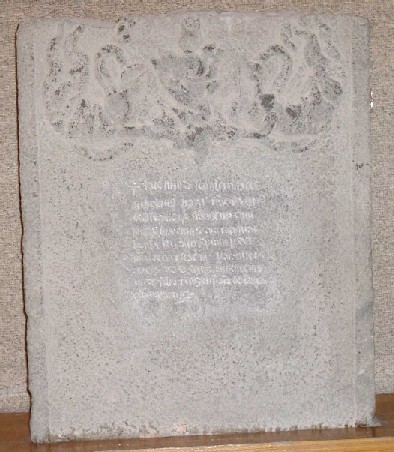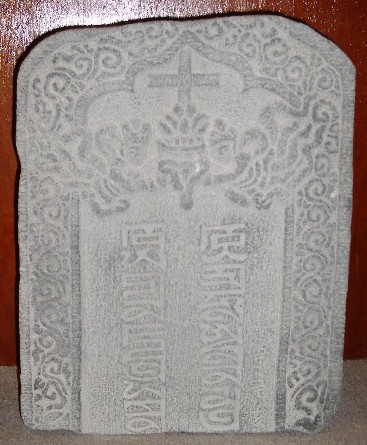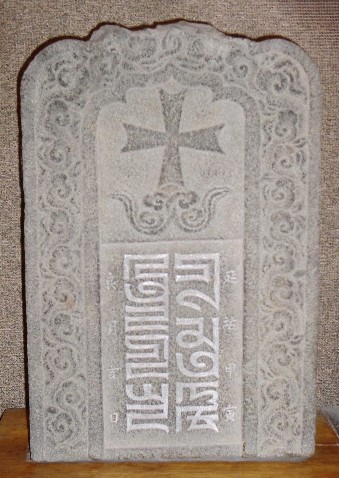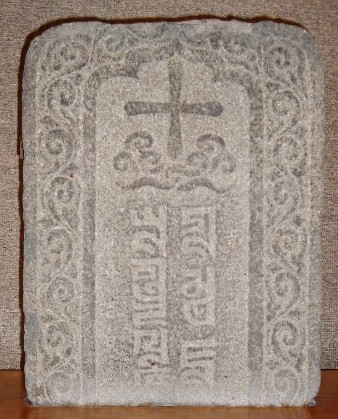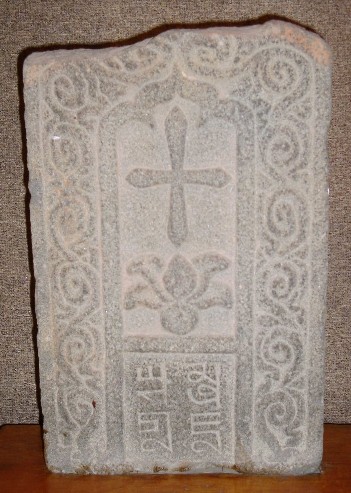BabelStone Blog
Saturday, 25 November 2006
Christian Tombstones of Zayton
Of the City and Great Haven of Zayton
Now when you quit Fuju [Fuzhou] and cross the River, you travel for five days south-east through a fine country, meeting with a constant succession of flourishing cities, towns, and villages, rich in every product. You travel by mountains and valleys and plains, and in some places by great forests in which are many of the trees which give Camphor. There is plenty of game on the road, both of bird and beast. The people are all traders and craftsmen, subjects of the Great Kaan, and under the government of Fuju. When you have accomplished those five days' journey you arrive at the very great and noble city of ZAYTON, which is also subject to Fuju.
At this city you must know is the Haven of Zayton, frequented by all the ships of India, which bring thither spicery and all other kinds of costly wares. It is the port also that is frequented by all the merchants of Manzi [southern China], for hither is imported the most astonishing quantity of goods and of precious stones and pearls, and from this they are distributed all over Manzi. And I assure you that for one shipload of pepper that goes to Alexandria or elsewhere, destined for Christendom, there come a hundred such, aye and more too, to this haven of Zayton; for it is one of the two greatest havens in the world for commerce.
Henry Yule and Henri Cordier (eds.), The Book of Ser Marco Polo, the Venetian, Concerning the Kingdoms and Marvels of the East (London: John Murray, 1903) Vol. II (Book II Chapter LXXXII).
Last year when I visited the ancient port city of Quanzhou 泉州 (Marco Polo's Zayton) on the East China coast (but now miles from the sea) I didn't yet have a blog, so for my slightly belated first anniversary blog post I thought I would discuss some of the pictures I took at the Quanzhou Museum of Maritime History (海外交通史博物館). The museum has a marvellous collection of stone monuments dating from the Yuan dynasty (1279-1368), with inscriptions in a wide range of scripts and languages, reflecting the cosmopolitan nature of the city in the 13th and 14th centuries, but I was particularly interested in its unique collection of Christian tombstones with inscriptions in the Phags-pa script.
Carving of Śiva from a Hindu temple
Tombstone of Bishop Andrew of Perugia
Christianity was first introduced into China from Central Asia during the early years of the Tang dynasty (618-907), as part of a widepread missionary movement by the Assyrian Church, the members of which are widely but inaccurately referred to as Nestorian Christians. Christianity in China was supressed in the mid ninth century, but underwent a revival under the Khitan and Mongol regimes from the 12th to the 14th centuries, and during the Yuan dynasty (1271-1368) the "Nestorian" church had a strong presence amongst the Uighur population in the western fringes of China.
It was also during the Yuan dynasty that the Catholic church first reached China. A series of Franciscan missions had been sent out by the papacy to Persia, India and China from the year 1241, but the first mission to actually reach China was that of John of Montecorvino (1246-1328), who had set out in 1289, and arrived at the capital of the Mongol Empire, known to Europeans of the time as Cambaluc (literally "City of the Khan", which is modern Beijing) in 1294. He built two churches in the capital, and is reputed to have translated the New Testament and Psalms into Chinese, but these translations no longer exist.
In 1307 Pope Clement V sent seven Franciscan friars, each with the rank of bishop, to China in order to consecrate John as Archbishop of China. Only three of the seven, Gerard, Peregrine (Peregrinus de Castello) and Andrew of Perugia (Andreas Perusinus), survived the long journey, arriving in Cambaluc in 1308.
Although John had established a strong presence in the capital, there were no missionary outposts elsewhere in China until Friar Gerard was sent to Zayton (Quanzhou) as bishop of the city. It seems that Zayton was chosen as the only bishopric outside the capital as it already had a Christian presence there in the form of a church that had been founded by a "rich Armenian lady". This church was established as a cathedral, and Gerard became the first bishop of Zayton. The fact that the existing church was converted into the Catholic cathedral would suggest that it may have been a Catholic church, and that at least some of the existing Christians of Zayton may have been Catholics associated with maritime trade rather than all Nestorians from Central Asia, who the Franciscans regarded as heretics.
After Gerard's death in 1313, Friar Peregrine was installed as the second bishop of Zayton. In 1318, Friar Andrew, who had remained at the capital, also went to Zayton, and built a new church outside the city. Four years later, in 1322, when Bishop Peregrine died, Andrew became the third bishop of Zayton, and he remained in this post until his death in 1332. It was whilst Andrew was bishop that Friar Odoric visited China, in his account of which he has this to say about Zayton :
30. Concerning the noble city called Zayton ; and how the folk thereof regale their gods.
Departing from that district, and passing through many cities and towns, I came to a certain noble city which is called Zayton, where we friars minor have two houses ; and there I deposited the bones of our friars who suffered martyrdom for the faith of Jesus Christ.
In this city is great plenty of all things that are needful for human subsistence. For example you can get three pounds and eight ounces of sugar for less than half a groat. The city is twice as great as Bologna, and in it are many monasteries of devotees, idol worshippers every man of them. In one of those monasteries which I visited there were three thousand monks and eleven thousand idols. And one of those idols, which seemed to be smaller than the rest was as big as St. Christopher might be. I went thither at the hour fixed for feeding their idols, that I might witness it ; and the fashion thereof is this : All the dishes which they offer to be eaten are piping hot so that the smoke riseth up in the face of the idols, and this they consider to be the idols' refection. But all else they keep for themselves and gobble up. And after such fashion as this they reckon that they feed their gods well.
The place is one of the best in the world, and that as regards its provision for the body of man. Many other things indeed might be related of this place, but I will not write more about them at present.
Henry Yule (trans. and ed.), Cathay and the Way Thither; being a collection of Medieval Notices of China (London: The Hakluyt Society, MDCCCLXVI) Vol. I pp.381-383.
After Andrew's death in 1332 a Paris theologian called Nicholas, who had arrived in China with twenty-six friars and six lay brothers, succeeded to the bishopric, but there are no detailed accounts of the later years of the Zayton mission. Nevertheless, the church in Zayton was evidentally still going strong when John Marignolli visited the city in about 1347 :
There is Zayton also, a wondrous fine seaport and a city of incredible size, where our Minor Friars have three very fine churches, passing rich and elegant ; and they have a bath also and a fondaco [a factory, i.e. "a mercantile establishment and lodging house in a foreign country"] which serves as a depôt for all the merchants. They have also some fine bells of the best quality, two of which were made to my order, and set up with all due form in the very middle of the Saracen community. One of these we ordered to be called Johannina, and the other Antonina.
Henry Yule (trans. and ed.), Cathay and the Way Thither; being a collection of Medieval Notices of China (London: The Hakluyt Society, MDCCCLXVI) Vol.II pp.115-116.
One of the last bishops of Zayton may have been a certain Friar James of Florence, who was martyred in the "Empire of the Medes" (i.e. the Empire of Chaghatai) in 1362, and is recorded to have been "Archbishop of Zaiton".
After the fall of the Mongol empire in 1368, the Catholic missions in China disappeared, and there was no further Catholic presence in China until the Dominican friar Gaspar da Cruz arrived in China in 1555.
Of the Franciscan bishops of Zayton, we know most about Andrew of Perugia (Andreas Perusinus), who was the third bishop from 1322 to 1332. This is his own account of the Zayton mission, that he wrote in a letter dated 1326 :
Friar Andrew of Perugia, of the Order of Minor Friars, by Divine permission called to be Bishop, to the reverend father the Friar Warden of the Convent of Perugia, health and peace in the Lord for ever !
.... On account of the immense distance by land and sea interposed between us, I can scarcely hope that a letter from me to you can come to hand. .... You have heard then how along with Friar Peregrine, my brother bishop of blessed memory, and the sole companion of my pilgrimage, through much fatigue and sickness and want, through sundry grievous sufferings and perils by land and sea, plundered even of our habits and tunics, we got at last by God's grace to the city of Cambaliech [modern Beijing], which is the seat of the Emperor the Great Chan, in the year of our Lord's incarnation 1308, as well as I can reckon.
There, after the Archbishop [John of Montecorvino] was consecrated, according to the orders given us by the Apostolic See [Pope Clement V], we continued to abide for nearly five years ; during which time we obtained an Alafa from the emperor for our food and clothing. An alafa is an allowance for expenses which the emperor grants to the envoys of princes, to orators, warriors, different kinds of artists, jongleurs, paupers, and all sorts of people of all sorts of conditions. And the sum total of these allowances surpasses the revenue and expenditure of several of the kings of the Latin countries.
As to the wealth, splendour, and glory of this great emperor, the vastness of his dominion, the multitudes of people subject to him, the number and greatness of his cities, and the constitution of the empire, within which no man dares to draw a sword against his neighbour, I will say nothing, because it would be a long matter to write, and would seem incredible to those who heard it. Even I who am here in the country do hear things averred of it that I can scarcely believe. ...
There is a great city on the shores of the Ocean Sea, which is called in the Persian tongue Zayton [properly known as Quanzhou in Chinese]; and in this city a rich Armenian lady did build a large and fine enough church, which was erected into a cathedral by the Archbishop himself of his own free-will. The lady assigned it, with a competent endowment which she provided during her life and secured by will at her death, to Friar Gerard the Bishop, and the friars who were with him, and he became accordingly the first occupant of the cathedral.
After he was dead however and buried therein, the Archbishop wished to make me his successor in the church. But as I did not consent to accept the position he bestowed it upon Friar and Bishop Peregrine before mentioned. The latter, as soon as he found an opportunity, proceeded thither, and after he had governed the church for a few years, in the year of the Lord 1322, the day after the octave of St. Peter and St. Paul, he breathed his last.
Nearly four years before his decease, finding myself for certain reasons uncomfortable at Cambaliech, I obtained permission that the before mentioned alafa or imperial charity should be allowed me at the said city of Zayton, which is about three weeks journey distant from Cambaliech. This concession I obtained as I have said, at my earnest request, and setting out with eight horsemen allowed me by the emperor, I proceeded on my journey, being everywhere received with great honour. On my arrival (the aforesaid Friar Peregrine being still alive) I caused a convenient and handsome church to be built in a certain grove, quarter of a mile outside the city, with all the offices sufficient for twenty-two friars, and with four apartments such that any one of them is good enough for a church dignitary of any rank. In this place I continue to dwell, living upon the imperial dole before-mentioned, the value of which, according to the estimate of the Genoese merchants, amounts in the year to 100 golden florins or thereabouts. Of this allowance I have spent the greatest part in the construction of the church ; and I know none among all the convents of our province to be compared to it in elegance and all other amenities.
And so not long after the death of Friar Peregrine I received a decree from the archbishop appointing me to the aforesaid cathedral church, and to this appointment I now assented for good reasons. So I abide now sometimes in the house or church in the city, and sometimes in my convent outside, as it suits me. And my health is good, and as far as one can look forward at my time of life, I may yet labour in this field for some years to come : but my hair is grey, which is owing to constitutional infirmities as well as to age.
'Tis a fact that in this vast empire there are people of every nation under heaven, and of every sect, and all and sundry are allowed to live freely according to their creed. For they hold this opinion, or rather this erroneous view, that everyone can find salvation in his own religion. Howbeit we are at liberty to preach without let or hindrance. Of the Jews and Saracens there are indeed no converts, but many of the idolaters are baptised ; though in sooth many of the baptised walk not rightly in the path of Christianity.
Four of our brethren have suffered martyrdom in India, at the hands of the Saracens ; and one of them was twice cast into a great blazing fire, but came out unhurt. And yet in spite of so stupendous a miracle not one of the Saracens was converted from his misbelief !
All these things I have briefly jotted down for your information, reverend father, and that through you they may be communicated to others. I do not write to my spiritual brethren or private friends, because I know not which of them are alive, and which departed, so I beg them to have me excused. But I send my salutation to all, and desire to be remembered to all as cordially as possible, and I pray you, father Warden, to commend me to the Minister and Custos of Perugia, and to all the other brethren. All the suffragan bishops appointed to Cambaliech and elsewhere by our lord Pope Clement have departed in peace to the Lord, and I alone remain. Friar Nicholas of Banthera, Friar Andrutius of Assisi, and another bishop [Ulrich Sayfusstorf], died on their first arrival in Lower India, in a most cruelly fatal country, where many others also have died and been buried.
Farewell in the Lord, father, now and ever. Dated at Zayton, A.D. 1326, in the month of January.
Henry Yule (trans. and ed.), Cathay and the Way Thither; being a collection of Medieval Notices of China (London: The Hakluyt Society, MDCCCLXVI) Vol.1 pp.496-499.
A tombstone believed to be that of Bishop Andrew was discovered in Quanzhou in 1946, and a copy of it is on display at the Quanzhou Museum of Maritime History (the original is in Beijing) :
Unfortunately the Latin inscription is badly worn and can only be partially read. The accepted reading of the inscription, made by Professor C. J. Fordyce in John Foster's "Crosses from the walls of Zaitun" (Journal of the Royal Asiatic Society (N.S.) 1954 pp. 1-25), is :
☩ Hic (in PFS) sepultus est
Andreas Perusinus (de-
votus ep. Cayton .......
.......ordinis (fratrum
min.) ..................
... (Jesus Christi) Apostolus
............................
........(in mense) .......
m(cccxx)xii ☩
But this reading does not seem to correspond well with what I can make out of the inscription :
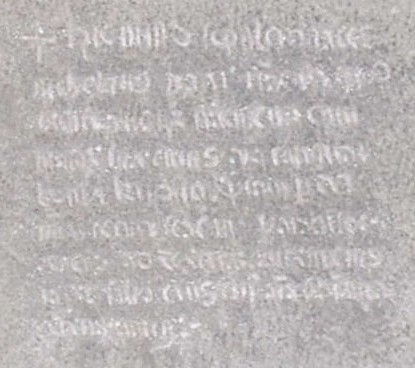
Click on image for different effects
Beyond the first word (hic) I find it difficult to match Fordyce's reading to the actual inscription, and in particular I do not see the words "Andreas Perusinus", so I have severe doubts about the validity of the accepted reading or whether it is indeed a memorial Bishop Andrew. I hope that perhaps some of my readers may be able to give me their suggested readings of the inscription (or parts of it or even single words).
My doubts are shared by eminent Sinologist Herbert Franke, who in Sino-Western Contacts under the Mongol Empire (Journal of the Hong Kong Branch of the Royal Asiatic Society Vol. 6 (1966)) states of this stone :
It must be Christian because the inscription begins
with the sign of the Cross, but the attempt to read it as Latin and
to regard it as the tomb inscription for Andrew of Perugia, the
third suffragan bishop of Zayton — modern Ch'uan-chou — does
not seem convincing. The only thing that can be said with certainty
is that the inscription is not in Syriac script.
But whether or not this is actually the tombstone of Bishop Andrew, it is still an extremely important artefact, as the only certain archaeological evidence of the 14th century Franciscan mission to Zayton.
For me the most interesting feature of this tombstone is the decoration above the Latin inscription. Although badly worn the carving clearly depicts two angels supporting a lotus flower upon which appears to be a seated figure wearing a bishop's mitre, confirming that the inscription is for one of the bishops of Zayton.
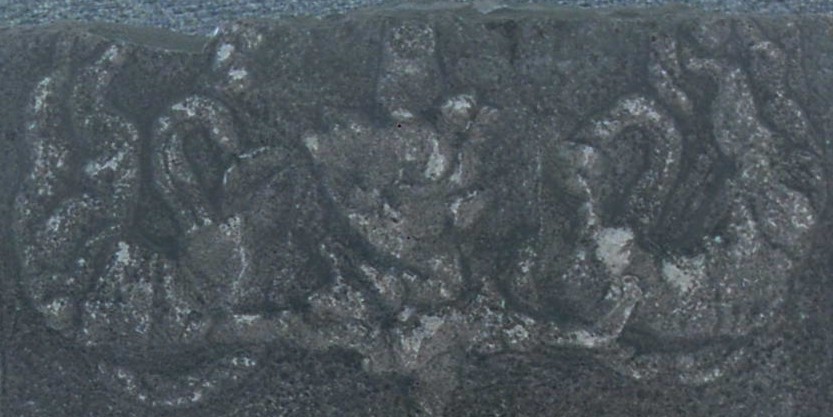
What is significant is that the image of two angels supporting a lotus flower is a common feature of tombstones attributed to Nestorian burials (see for example the two uninscribed headstones shown in the Christian Angels on the South China Coast exhibition, The Stones of Zayton Speak fig.33, and the tombstone dated 1311 shown below), and they have therefore been seen as emblematic symbols of the Assyrian church in China. Yet here they are on the tombstone of a bishop of an order which regarded the Nestorians as heretics. I suspect that the answer is simply that angels supporting a lotus flower is what the craftsmen employed to carve the tombstone were used to carving, so when commissioned to carve a tombstone for Bishop Andrew they naturally carved him seated on a lotus flower supported by two angels. But what this means is that the image of two angels supporting a lotus flower cannot necessarily be taken to be conclusive proof that the person commemorated on the tombstone actually belonged to the Assyrian church.
Tombstones with Phags-pa Inscriptions
In addition to the supposed tombstone of Bishop Andrew discussed above, up to forty other Yuan dynasty Christian tombstones have been unearthed in Quanzhou (see The Stones of Zayton Speak for various examples of both Christian and Muslim tombstones). Amongst these are four highly unusual examples that have their main inscription written in Chinese using the Phags-pa script, which is a Tibetan-based script devised by the 'Phags-pa Lama at the behest of Khubilai Khan in 1260 for use as the national script of the Mongol Empire, and which was used to a limited extent for writing both Mongolian and Chinese during the 13th and 14th centuries. (Note that these inscriptions are not "bilingual texts in a Turkic language, using Phagspa script, and Chinese" as claimed in The Stones of Zayton Speak.)
Most of the inscribed Christian tombstones from Quanzhou have inscriptions written in the Uighur language using the Syriac script, and are without doubt memorials to members of the Assyrian church who originally came from the western parts of the empire. Many similar tombstones with Syriac inscriptions have also been found in the west of China and elsewhere in central Asia, especiially Kyrgyzstan. However the four tombstones shown below differ from the typical Uighur/Syriac examples in that their inscriptions are in the Chinese language (spelled phonetically using the Phags-pa script), and the names of the deceased are ordinary Chinese names, and so they would seem to be memorials to Han Chinese Christian converts rather than to Uighurs from central Asia. It has always been assumed that all the Christian tombstones of Quanzhou are relics of the "Nestorian" (i.e. Assyrian) church, but as I have suggested above, the supposed Nestorian symbols on the tombstones below may not necessarily be indicative of a Nestorian burial, as they are also found on the tombstone of the Franciscan Bishop Andrew (cf. especially the decoration on the 1311 Phags-pa tombstone below with the decorative carving on the tombstone of Bishop Andrew). The tombstones with Phags-pa inscriptions are dated 1311, 1314 and 1324, which makes them exactly contemporary with mission in Zayton of Bishops Gerard, Peregrine and Andrew (c.1308-1332). Without any knowledge of their archaeological context (because I stupidly managed not to buy the newly revised and expanded treatise on Quanzhou religious carvings by Wu Wenliang that had just been published the previous year) it is difficult to make any judgement, but I do wonder if it is possible that these particular tombstones were actually associated with the Franciscan bishopric of Zayton rather than the Assyrian church.
The use of Phags-pa script for writing Chinese is especially suggestive to me, as although the script was used to write Mongolian and Chinese in official documents and on monumental inscriptions of imperial edicts, as well as on coins, banknotes and seals, it was rarely used for non-governmental purposes, and I do not know of any other examples of tombstones, for any religion, that have inscriptions in the Phags-pa script. Giving the names of deceased in Phags-pa script is especially problematic as it is often not possible to be certain which particular Chinese character a Phags-pa syllable is intended to represent, especially as the Phags-pa script does not indicate tone, and so my transcriptions of the Phags-pa inscriptions into Chinese characters is in places only tentative (and sometimes differs from the transcriptions given in other studies of the tombstones). Ironically, the date, which could be written unambiguously in the Phags-pa script, is always written using Chinese characters. The question has to be asked, given that the Phags-pa script cannot distinguish between ideographic homophones and the tombs are for Han Chinese with ideographic names, why then is the main inscription written in the Phags-pa script ? It may well have been that the Franciscan missionaries promoted the use of the phonetic Phags-pa script over the native ideographic script as it was easier for them to read and write Chinese with it, and if these were the tombstones of converts to the Franciscan church at Quanzhou then that would explain why their inscriptions are in the Phags-pa script.
It is also interesting to note that the inscriptions themselves have no Christian content, but use exactly the same forms of wording that are found on ordinary non-Christian Chinese tombstones of the time. The cross and angels are the only indications that these are in fact Christian monuments. This contrasts with the Christian tombstones in the Syriac script which do include overt Christian text (see for example The Stones of Zayton Speak figs.16 and 18 which both start with the words "In the name of the Father, the Son, and the Holy Spirit..." in Uighur).
Tombstone of Zhu Yanke (1311)
The main inscription reads ꡁꡗ ꡚꡋ ꡆꡦꡟ ꡗꡠꡋ ꡁꡡ ꡒꡜꡞ ꡝꡧꡞꡋ ꡏꡟ khay shan jėu yen kho dzhi 'win mu in Phags-pa script, representing Chinese kāishān zhū yánkě zǐyún mù 開山朱延可子雲墓 "tomb of Zhu Yanke [styled] Ziyun of Kaishan". An inscription in Chinese on either side reads 至大四年辛亥,仲秋朔日謹題 "In the cyclical year xinhai [year of the golden pig] in the fourth year of the Zhida period, respectfully inscribed on the first day of the second autumn month". Zhida 4 corresponds to the year 1311.
The Phags-pa text of this tombstone has also been interpreted as "開山朱延可訾雲墓".
Tombstone of Yang Wengshe (1314)
The main inscription reads ꡖꡟꡃ ꡚꡦ ꡗꡃ ꡚꡞ ꡏꡟ ꡈꡓ -ung shė yang shi mu taw in Phags-pa script, representing Chinese wēngshè yáng=shì mùdào 翁舍楊氏墓道 "tomb memorial of Yang Wengshe". An inscription in Chinese on either side reads 延祐甲寅,良月吉日 "In the cyclical year jiayin [year of the wooden tiger] of the Yanyou period, on a good month and an auspicious day". The cyclical year jiayin is the first year of the Yanyou period, corresponding to the year 1314.
The Phags-pa text of this tombstone has also been interpreted as "翁葉楊石墓道".
Tombstone of Liu Yigong (1324)
The main inscription reads ꡗꡞ ꡂꡟꡃ ꡙꡞꡓ ꡚꡞ ꡏꡟ ꡆꡞ yi gung liw shi mu ji in Phags-pa script, representing Chinese yìgōng (liú/liǔ)-shì mùzhì 易公(劉/柳)氏墓誌 "tomb memorial of Liu Yigong" (the family name may be either Liú 劉 or Liǔ 柳, as Phags-pa script does not indicate tone). A faint inscription in Chinese on either side reads 旹歲甲子,仲春吉日 "In the cyclical year jiazi [year of the wooden rat], on an auspicious day of the second spring month". The cyclical year jiazi can only refer to the first year of the Taiding 泰定 period, corresponding to the year 1324.
The Phags-pa text of this tombstone has also been interpreted as "易公柳濟墓址" or "易公劉石墓誌".
Tombstone of Madam Ye (undated)
The inscription reads ꡗꡠ ꡚꡞ ꡏꡟ ꡆꡞ ye shi mu ji in Phags-pa script, representing Chinese yè-shì mùzhì 葉氏墓誌 "tomb memorial of Madam Ye". This is the only Phags-pa tombstone inscription that does not also give a date in Chinese script.
The Phags-pa text of this tombstone has also been interpreted as "葉氏墓址" or "葉石墓誌".
Appendix : Note on the name "Zayton"
Quanzhou was known to European travellers to China as Zayton (in various spellings), from the Arabic name for the city, Zaitún, meaning an olive tree. However the Arabic Zaitún is in fact a corruption of the Chinese name for the coral tree (Erythrina variegata), citong 刺桐 "prickly tong". Because Quanzhou was famed for its coral trees, since the Tang dynasty (618-907) it had been known informally as the "city of coral trees" (citong cheng 刺桐城), and this literary epithet was later adopted as Zaitún "olive tree" by Arab traders.
For centuries after Marco Polo's account of the splendours of Zayton were first made known to Europe, no-one knew exactly where Zayton was, and some even thought that it was a spurious, made-up name. It was only at the end of the 19th century that Zayton was conclusively identified as Quanzhou.
The name Zayton has passed into the English language as the word "satin", which derives from the Arabic zaitúníah (via medieval Italian zettani, Spanish aceytuni or French zatony), being the name for the rich satins from Zayton, for which Quanzhou was renowned, as can be seen from the account of Ibn Batuta, who visited China in the 1340s :
The first city that I reached after crossing the sea was ZAITÚN. ... It is a great city, superb indeed; and in it they make damasks of velvet as well as those of satin, which are called from the name of the city Zatúníah ; they are superior to the stuffs of Khansá [Hangzhou] and Khárbálik [modern Beijing]. The harbour of Zaitún is one of the greatest in the world -- I am wrong; it is the greatest! I have seen there about an hundred first-class junks together ; as for small ones, they were past counting. The harbour is formed by an estuary which runs inland from the sea until it joins the Great River.
Further Reading
Web Sites
- Manichaean and (Nestorian) Christian Remains in Zayton (Quanzhou, South China)
- The Stones of Zayton Speak (China Heritage Newsletter No. 5, March 2006)
- Christian Angels on the South China Coast
- Macquarie University Library Exhibitions 2003 (includes links to photos not shown on the official exhibition page)
- Yang Xiaochun 楊曉春, 二十年來中國大陸景教研究綜述(1982—2002) (originally published in Zhongguoshi Yanjiu Dongtai 中國史研究動態 2004.6)
Publications
- Wu Wenliang 吳文良, Quanzhou Zongjiao Shike 泉州宗教石刻. Beijing: Kexue Chubanshe, 1957 (1st ed.) and 2005 (2nd ed., revised by his son, Wu Youxiong).
- Zheng Zhenman 鄭振滿 and Ding Hesheng 丁荷生, Fujian Zongjiao Beiming Huibian : Quanzhoufu fence 福建宗教碑銘彙編 : 泉州府分册 (3 vols.). Fuzhou: Fujian Renming Chubanshe, 2003.
- Junast 照那斯圖, "Yuandai Jingjiaotu mubei basibazi kaoshi" 元代景教徒墓碑八思巴字考釋. In Haijiaoshi Yanjiu 海交史研究 1994.2.
- Niu Ruji 牛汝極, "Quanzhou chutu Huihuwen Yelikewenjiao (Jingjiao) mubei yanjiu" 泉州出土回鶻文也里可溫教(景教)墓碑研究. In Xueshu Jilin 學術集林 vol.5 (Shanghai Yuandong Chubanshe, 1995).
- Niu Ruji 牛汝極, "Cong chutu beiming kan Quanzhou he yangzhou de Jingjiao laiyuan" 從出土碑銘看泉州和揚州的景教來源. In Shijie Zongjiao Yanjiu 世界宗教研究 2003.2.
- Pearson, Richard, Li Min and Li Guo, "Quanzhou Archaeology: A Brief Review". In International Journal of Historical Archaeology 6:1 (2002).
- Schottenhammer, A., ed., The Emporium of the World: Maritime Quanzhou, 1000–1400. Leiden: Brill, 2001.
Last updated: 2021-02-20.
Index of BabelStone Blog Posts

